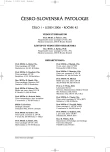Pyloric Gland Adenoma – How to Diagnose?
Jak diagnostikovat adenom z pylorických žlázek?
Název „adenom z pylorických žlázek“ vyjadřuje původ nádoru z hlubokých mucinózních žlázek žaludku. Diagnózu tohoto nádoru je možno potvrdit imunohistochemicky; typicky je silně pozitivní pro Mucin 6 (hluboké slizniční žlázky žaludku). Nádor exprimuje Mucin 6 v celém svém rozsahu, až k povrchu, často s tenkou vrstvou cylindrického epitelu exprimující Apomucin 5AC. Množství mucinu 5AC, který je normálně exprimován apikálním foveolárním epitelem, je u jednotlivých případů různé. Někdy lze pozorovat kombinaci či transdiferenciaci s běžným tubulárním adenomem (s intestinální diferenciací). Nádorem bývá nejčastěji postižena sliznice žaludečního těla starých žen s autoimunní gastritidou. Častost adenomu z pylorických žlázek je v literatuře udávána na 2,7 % všech žaludečních polypů. Adenom z pylorických žlázek proto není tak vzácný jak se dosud předpokládalo. Skutečnost, že o tomto nádoru existuje jen málo publikací, nutí předpokládat, že je často chybně diagnostikován. Adenom z pylorických žlázek může vzniknout v heterotopické či metaplastické žaludeční sliznici kdekoli v gastrointestinálním traktu. Je klinicky závažný, protože až v 30 % dochází k jeho malignímu zvratu. Tyto nádory mají většinou charakter dobře diferencovaného časného adenokarcinomu, omezeného na vlastní sliznici a po úplné polypektomii mají výbornou prognózu.
Klíčová slova:
adenom z pylorických žlázek – pyloric gland adenoma – žaludek – polyp – adenokarcinom
Authors:
M. Vieth; C. Vogel; R. Kushima; F. Borchard; M. Stolte
Authors‘ workplace:
Institute of Pathology, Klinikum Aschaffenburg, Germany
; Institute of Pathology, Shiga University, Ohtsu, Japan
; Institute of Pathology, Klinikum Bayreuth, Germany
Published in:
Čes.-slov. Patol., 42, 2006, No. 1, p. 4-7
Category:
Invited Article
Overview
The term “pyloric gland adenoma” reflects its etiogenesis from deep mucoid glands in the stomach. The diagnosis can be confirmed by immunohistochemistry. Typically, pyloric gland adenomas are strongly positive for Mucin 6 (deep mucoid gastric glands). These lesions express Mucin 6 over the whole lesion up to the surface often only with a small layer of columnar epithelium expressing Apomucin 5AC. The amount of mucin 5AC which is expressed on normal within the apical foveolar epithelium might vary from case to case. Combination or transdifferentiation with ordinary tubular (intestinal differentiation) adenoma can be observed. The gastric corpus mucosa of elderly female patients with autoimmune gastritis is highly affected. The frequency of pyloric gland adenoma is given in the literature being 2.7% of all gastric polyps. Therefore pyloric gland adenomas are not that rare that one might assume. Only a few publications are available which makes one think that these lesions are frequently misinterpreted. Pyloric gland adenomas can arise in gastric heterotopia and gastric metaplasia in the whole gastrointestinal tract. The clinical significance is given by a 30% rate of malignant transformation. These cases represent for the most well differentiated early adenocarcinomas which are known to have an excellent prognosis after complete polypectomy and limitation to the mucosal layer.
Key words:
pyloric gland adenoma – gastric polyp – adenocarcinoma
Labels
Anatomical pathology Forensic medical examiner ToxicologyArticle was published in
Czecho-Slovak Pathology

2006 Issue 1
Most read in this issue
- Cervical Cancer Precursors: Cytohistologic Correlation with the Results of HPV Testing
- Pyloric Gland Adenoma – How to Diagnose?
- Isolated Lymphadenopathy as the First Presentation of Systemic Mastocytosis – Description of Two Cases
- Malignant Fibrous Histiocytoma of the Breast: Report of Two Cases
